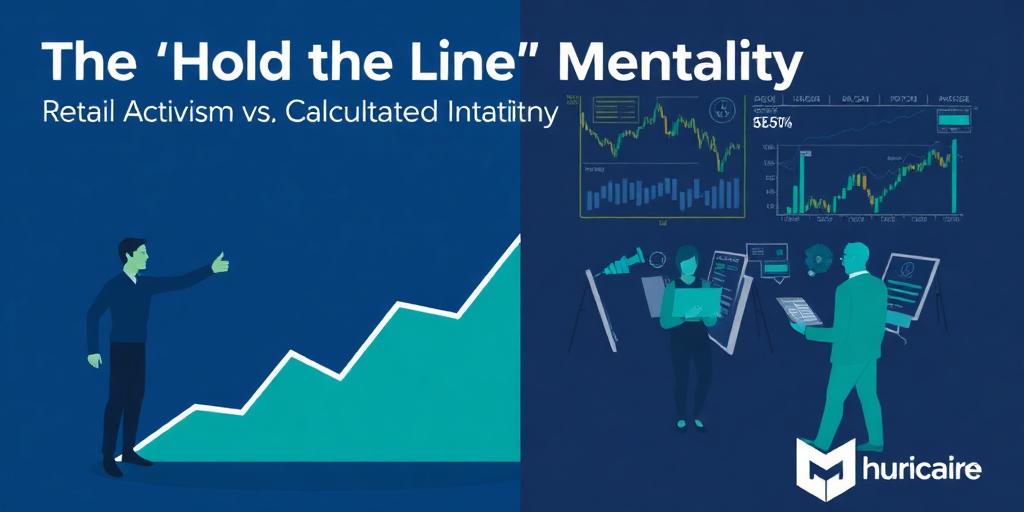The "Hold the Line" Mentality: Retail Activism vs. Calculated Institutional Strategy
The financial landscape is constantly evolving, and with it, the strategies employed by investors. Two distinct approaches have emerged, each with its own merits and drawbacks: the "Hold the Line" mentality prevalent among retail investors and the calculated institutional strategies employed by larger firms. This post will explore these contrasting approaches, providing an informative analysis of their characteristics, benefits, and potential pitfalls.
Understanding the "Hold the Line" Mentality
The "Hold the Line" mentality is often observed among retail investors, particularly those who are passionate about specific companies or investment themes. It is characterized by a steadfast refusal to sell investments, even in the face of adverse market conditions or negative news. This approach is frequently rooted in a strong belief in the long-term potential of the investment, a sense of loyalty to the company, or a resistance to admitting a mistake.
Characteristics of the "Hold the Line" Mentality:
- Emotional Attachment: Decisions are often driven by emotions rather than rational analysis.
- Long-Term Focus: Emphasis on the future potential, often overlooking short-term risks.
- Resistance to Loss: Unwillingness to sell at a loss, hoping for a turnaround.
- Community Influence: Heavily influenced by online communities and social media sentiment.
Potential Benefits:
- Potential for High Returns: Holding through volatility can lead to significant gains if the investment eventually succeeds.
- Reduced Transaction Costs: Avoiding frequent trading minimizes fees and taxes.
- Simplicity: Requires less active management and monitoring.
Potential Pitfalls:
- Opportunity Cost: Capital may be tied up in underperforming assets, missing out on better opportunities.
- Increased Risk: Holding through prolonged downturns can lead to substantial losses.
- Emotional Distress: Watching investments decline without taking action can be stressful.
Calculated Institutional Strategies
In contrast to the emotionally driven "Hold the Line" approach, institutional investors typically employ calculated strategies based on rigorous analysis and risk management. These strategies are designed to maximize returns while minimizing risk, often involving active trading and diversification.
Characteristics of Calculated Institutional Strategies:
- Data-Driven Analysis: Decisions are based on quantitative and qualitative research.
- Risk Management: Emphasis on minimizing potential losses through diversification and hedging.
- Active Portfolio Management: Frequent adjustments to the portfolio based on market conditions.
- Professional Expertise: Reliance on experienced analysts and portfolio managers.
Potential Benefits:
- Optimized Returns: Active management aims to capitalize on market opportunities and avoid losses.
- Reduced Risk: Diversification and hedging mitigate the impact of individual investment failures.
- Disciplined Approach: Decisions are based on a pre-defined strategy, minimizing emotional biases.
Potential Pitfalls:
- Higher Transaction Costs: Frequent trading leads to increased fees and taxes.
- Complexity: Requires significant expertise and resources to implement effectively.
- Potential for Underperformance: Active management does not guarantee superior returns.
Key Differences and Considerations
| Feature | "Hold the Line" Mentality | Calculated Institutional Strategies | | ------------------- | --------------------------- | ----------------------------------- | | Decision-Making | Emotional, Belief-Driven | Data-Driven, Analytical | | Risk Management | Limited | Comprehensive | | Portfolio Management| Passive | Active | | Time Horizon | Long-Term | Variable | | Expertise | Limited | High |
Conclusion
Both the "Hold the Line" mentality and calculated institutional strategies have their place in the investment world. The suitability of each approach depends on individual circumstances, risk tolerance, and investment goals. Retail investors embracing the "Hold the Line" approach should be aware of the potential risks and ensure their decisions are grounded in sound analysis rather than pure emotion. Institutional investors, while benefiting from sophisticated strategies, must remain vigilant about costs and the potential for underperformance. Ultimately, a balanced and informed approach is crucial for navigating the complexities of the financial markets.
Long-Tail Keywords
- Retail investor strategy
- Institutional investment approach
- Holding stocks through market downturns
- Risk management in investing
- Emotional investing vs. rational investing









